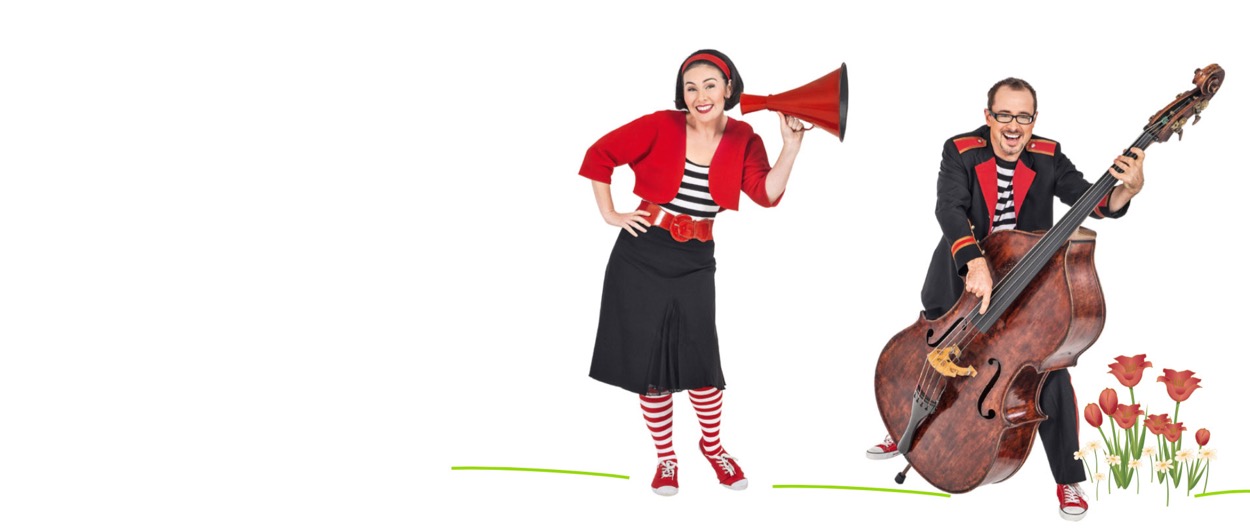

Pitch refers to how high or low a sound is.
All sounds are caused by vibrations: fast vibrations make high pitched sounds, while slow vibrations make low pitched sounds. Join Lah-Lah’s Big Live Band as they create different pitches with their voices and instruments.

- Identify and sing low, medium and high pitched sounds
- Identify pitch direction (going up, down, or staying the same)
- Pitch matching
- Representing music through informal notation.

Read aloud or retell the story of ‘Goldilocks and the Three Bears’ to your class, focussing on using different pitched voices for the characters. Papa Bear has the lowest and gruffest voice, while Baby Bear has the highest and squeakiest voice.
I changed my voice as I read each character’s words. How would you describe the different voices I used? Can you speak like Papa Bear or Baby Bear?
When we make our voices higher or lower, we are changing the ‘pitch’ of our voices. Musicians use pitch just like readers do: changes in pitch make our reading and our music more interesting!
Teacher Tutorials
Explainer
Elaboration
Extension
Music Clips
High or Low for the Show
Hiding
Band on the Bus – Meet the Stringalings
Lessons
Lesson 1
WALT: Identify high, medium and low pitched voices.
Discussion starter
Watch the Lah-Lah’s Adventures clip ‘High or Low for the Show’ with your class to introduce the concept of pitch. Buzz wants to sing low, like Lola the Dancing Double Bass, but Lah-Lah wants to sing high.
Ask students to experiment with high and low pitched voices. Can you sing high like Lah-Lah? Or low like Buzz? What do you think a medium pitched voice sounds like? Try singing from low to high, or high to low.
Learning task
Play the ‘Pitch River’ game with your class to practise listening for pitch. Mark a line on the floor with rope, masking tape or chalk, and explain to students that one side of the ‘river’ is for high pitch sounds and the other is low. The river itself is for medium pitch sounds.
Beginning slowly and gradually speeding up, sing high, medium or low notes at random and have students jump to the corresponding position on the floor. If the class is struggling to distinguish the different pitches, you could give an additional visual cue by holding your hand high, medium or low. If a student jumps to the wrong position, they are out of the game. Were low, medium or high pitch sounds trickiest to identify?
Variations include playing different pitched notes on an instrument rather than singing, or having a student lead the game. As an extension, you could mark five equally spaced lines on the floor to represent a musical stave and have students jump to these points.
Lesson 2
WALT: Identify and match different pitched voices.
Discussion starter
Melodies in music are made up of changing pitches, so tuneful singing begins with the ability to listen for, match, and sing different pitches. Watch the Lah-Lah’s Adventures clip ‘Hiding’ with your class, then discuss the different pitched voices in the song.
How would you describe the song? Did the pitch stay the same throughout the song, or did it change? Who sang high and who sang low? Could you predict when the pitch was about to change?
Learning task
Ask students to again experiment with different pitched voices. Do you like singing high like Lah-Lah or low like Buzz? How high and low can your voice go? How does it feel when your voice goes very high or low? Do we all have the same range of pitches? Why, or why not?
Challenge the class to be your echo as you sing at different pitches. (It will be easiest to start with a one-syllable word like ‘lah’, or short phrases from familiar nursery rhymes.) Begin by singing at a pitch close to your students’ speaking voices before moving on to higher or lower pitches. Students might benefit from visual feedback while they sing, such as lowering your hand to ask for a lower pitch.
Play the ‘Hiding’ clip again, asking students to echo Lah-Lah each time she sings the word ‘hiding’. To sing like Lah-Lah, your voice will need to go from high to low. Students will enjoy moving around the room to the music as they sing. Echo singing is a technique that you can use over and over again, both to practise pitch matching or other elements of music, and to learn new songs as a class.
Lesson 3
WALT: Play high and low sounds.
Discussion starter
Just as voices can be low, medium or high, instruments also make different pitched sounds. Can you think of any instruments that make very high or very low sounds?
Watch the Lah-Lah’s Adventures clip ‘Band on the Bus – Meet the Stringalings’ to explore the different pitched sounds of the string family, then discuss students’ observations.
Learning task
Lola the Dancing Double Bass is very large and makes a low pitched sound, while the violin is very small and makes a high pitched sound. (This is because sound vibrates quickly in small objects, and slowly in large objects.) Explain and discuss that the relationship between size and pitch is a general rule for musical instruments, and in the natural world.
Can you think of something small that makes a high sound, such as a bike bell? Or something large that makes a low sound, like a truck’s horn. Can you think of anything that breaks this rule? For example, a small bullfrog has a low croak, and a big piano can make high sounds. Electronic devices like computers can make both high and low sounds.
Hold a pitch ‘treasure hunt’ in the classroom. Working individually or in small groups, ask students to find instruments or objects that make high pitched or low pitched sounds. Sounds could be produced by tapping, scraping, blowing, or some other way of ‘playing’. Students then share their findings with the class, discussing whether their item’s pitch corresponds with its size or not.
Lesson 4
WALT: Identify pitch direction (going up, going down, or staying the same).
Discussion starter
Watch the Lah-Lah’s Adventures clip ‘High or Low for the Show’with your students again. Which body movements did Buzz and Lah-Lah use when they were talking about high and low singing? Can you think of any different body movements for high and low sounds?
Group students in pairs, asking one student to be the ‘singer’ and the other to be the ‘mover’. Ask the singers to sing a word, and their partners to respond to their pitch with a corresponding movement. For example, they might stand on their toes and lift their arms high for a high pitched voice, or crouch down for a low voice. Try singing in a pitch that goes up and down like a siren, or keeping your pitch the same for a long time. Students can then switch roles.
Learning task
We have represented pitch with body movements; now let’s represent different pitches through drawing. On the whiteboard, draw a single wavy line with hills and valleys. Ask students to identify the high and low parts of the line drawing. Can you change the pitch of your voice to go up and down like the line? The rising and falling pitch sounds like a siren.
On mini whiteboards or pieces of paper, have students draw their own pitch line drawing. Drawings might include wavy lines or zigzags, or a series of dots and dashes. Sitting in a circle, ask students to share their drawings and have their classmates attempt to replicate the pitches they have drawn. Which drawings were hardest to sing? Why? Can you think of any other ways to represent pitch visually?
You could keep these pitch drawings to use in future pitch matching exercises, or as vocal warm-ups before singing.
Assessment
What have you learnt about pitch? How could you use this knowledge in your singing?
Do students understand the concept of pitch, and can they articulate this? Can they identify high, medium and low pitch sounds in voices and instruments? Can they identify changes in pitch direction? Can students sing high and low sounds to match pitch?
Assessment strategies include:
- Teacher observations
- Checklists for the target knowledge and skills
- Use a smart phone or tablet to record students identifying, matching and creating different pitched sounds
- Photograph and annotate student work samples, such as the pitch line drawings.

